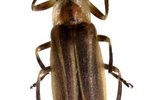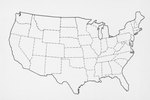
Mole crickets refer to family Gryllotalpidae insects that, like the tiny-eyed mammalian moles of their naming, lead subterranean lives. Although their underground burrowing habits have given them reputations as major nuisances, these nocturnal invertebrates are essentially innocuous to people, as they're incapable of either stinging or biting.
About Mole Crickets
Mole crickets are beige or brown, with typical body lengths of approximately 1 inch. They possess squat limbs that are kept tightly against their physiques. Their bodies are adorned with tiny hairs that are either grayish-brown or deep brown. Mole crickets have big eyes and antennae that are highly inconspicuous. They have wings and most of them are capable of flying, too. While the nymphs look a lot like mature specimens, they are markedly darker and free of wings. As far as habitats go, they favor dirt that is simultaneously light and damp, especially if it consists of elements of decaying agricultural crops or animal dung.
Underground for Burrowing
Mole crickets reside underground for purposes of burrow construction. They establish intricate burrows that are generally between 3 and 4 inches lower than the top of the dirt. As they burrow, they simultaneously pull out roots and grasses, which is why they're considered by many to be such pests. When they reproduce, they deposit their eggs inside of segments within the soil. Nymphs generally transition into mature crickets after a few months.
Underground for Feeding
Mole crickets don't only live underground for digging out their tunnels, but also for basic feeding purposes. Being underground enables them to dine on roots of vegetation -- one of their big dietary staples. They also regularly eat stems and tubers. Life underground allows these crickets to easily munch on bug larvae, too, as larvae often are found underneath the ground's surface.
Extremely Cold Temperatures
As cold-blooded creatures, mole crickets are unable to move when it's freezing outside. They get through this by staying underground and staying inactive. Mole crickets require elevated temperatures to move around, and even more elevated temperatures to fly. Their "hibernation" burrows are markedly deeper than those from other times of the year.
Soil Adaptations
Mole crickets' bodies possess numerous adaptations that assist them in their underground lifestyles. Their bodies are sleek, which allows them to travel through dirt with ease. Their front limbs are wide and equipped with several pointy spikes. They employ these strong legs to push dirt behind them, which is how they go about digging out their tunnels. Lastly, mole crickets bodies' have sturdy coatings that defend them against the excessive friction of dirt.
References
- Pests of Field Crops and Pastures; P.T. Bailey
- Insect Pests of Rice; M.D. Pathak
- Crickets; Cari Meister
- Insects and Spiders of the World; Barbara J. Abraham et al.
- University of Florida Entomology & Nematology: Basic Biology of Mole Crickets
- Iowa State University Department of Entomology: Mole Crickets
- IPM North Carolina: Mole Crickets
- UGA Center for Urban Agriculture: The Best Time to Control Mole Crickets
- Texas A&M AgriLife Extension: Mole Cricket
Photo Credits
-
Photos.com/Photos.com/Getty Images




